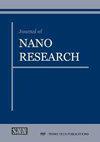Heat Transfer Investigation of Laminar Flow Mixed Convection of Nanofluids in a Uniformly Heated Horizontal Annulus: A Combination of Theoretical-Based and Experimental-Based Models of Thermal Conductivity and Viscosity
IF 1
4区 材料科学
Q4 MATERIALS SCIENCE, MULTIDISCIPLINARY
引用次数: 0
Abstract
This present study is intended for a CFD analysis of hydrodynamic and thermal characteristics of water-based fluid containing TiO2 or CuO nanoparticles flowing in laminar regime in a 3D uniformly heated horizontal annulus utilizing several. Four distinct models have been developed using various combinations (A, B, C and D) of the available theorical-based and experimental-based thermal conductivity and viscosity correlations. A CFD-Fortran code based on the finite volume technique was elaborated for the numerical solution of the mathematical model of the problem. The implications of Grashof number, volume fraction, and type of nanoparticle on isovelocity, isotherms, mean and wall temperatures, Nusselt number, heat transfer coefficient, pressure drop, and thermal performance evaluation criteria are explored using these different models. The results demonstrate that the Nusselt number and heat transfer coefficient of all developed models improve with the addition of nanoparticles. For 2% of nanoparticles’ concentration, the largest enhancement was reached for model D by about 23.5% with respect to the based liquid, while the smallest enhancement was obtained for model B by about 1.16%. The highest Performance Evaluation Criteria (PEC) are attained by employing model D by about 1.263, followed by model C by about 1.074.纳米流体在均匀加热的水平环空中层流混合对流的传热研究:基于理论和实验的导热性和粘度模型的结合
本研究旨在CFD分析含有TiO2或CuO纳米颗粒的水基流体在三维均匀加热的水平环空中以层流状态流动的流体动力学和热特性。利用现有的基于理论和基于实验的导热系数和粘度相关性的不同组合(A、B、C和D),开发了四种不同的模型。本文编写了基于有限体积技术的CFD-Fortran代码,对问题的数学模型进行了数值求解。利用这些不同的模型,探讨了格拉什夫数、体积分数和纳米颗粒类型对等速、等温线、平均温度和壁温、努塞尔数、传热系数、压降和热性能评价标准的影响。结果表明,纳米粒子的加入提高了模型的努塞尔数和传热系数。当纳米颗粒浓度为2%时,模型D相对于基液的增强效果最大,约为23.5%;模型B相对于基液的增强效果最小,约为1.16%。采用D模型获得的绩效评价标准(PEC)最高,约为1.263,其次是C模型,约为1.074。
本文章由计算机程序翻译,如有差异,请以英文原文为准。
求助全文
约1分钟内获得全文
求助全文
来源期刊

Journal of Nano Research
工程技术-材料科学:综合
CiteScore
2.40
自引率
5.90%
发文量
55
审稿时长
4 months
期刊介绍:
"Journal of Nano Research" (JNanoR) is a multidisciplinary journal, which publishes high quality scientific and engineering papers on all aspects of research in the area of nanoscience and nanotechnologies and wide practical application of achieved results.
"Journal of Nano Research" is one of the largest periodicals in the field of nanoscience and nanotechnologies. All papers are peer-reviewed and edited.
Authors retain the right to publish an extended and significantly updated version in another periodical.
 求助内容:
求助内容: 应助结果提醒方式:
应助结果提醒方式:


